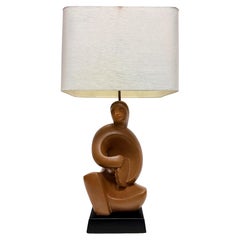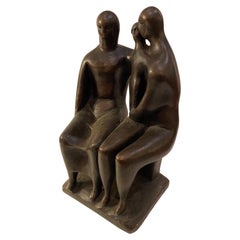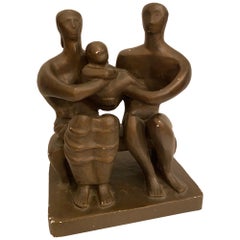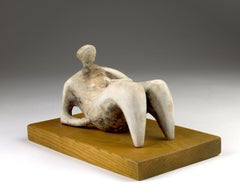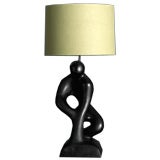Henry Moore Plaster
RIMA 1940s Cubist Abstract Plaster Musician Lamp, Henry Moore Influenced
By RIMA, Henry Moore
Located in Miami, FL
RIMA 1940s Cubist Abstract Plaster Musician Lamp, Henry Moore Influenced
Offered for sale is a
Category
Mid-20th Century American Mid-Century Modern Table Lamps
Materials
Metal
$1,200
H 30.5 in W 9.5 in D 7.75 in
Henry Moore Austin Productions
By Austin Productions, Henry Moore
Located in Philadelphia, PA
Austin productions Henry Moore Style Statue. Signed and dated 1964 to back. In overall very good
Category
Vintage 1960s American Mid-Century Modern Abstract Sculptures
Materials
Plaster
Austin Productions Henry Moore Style Seated Family
By Austin Productions, Henry Moore
Located in Philadelphia, PA
Austin Productions Henry Moore Family on Bench. Plaster cast with a bronze finish. Shows a few
Category
Vintage 1960s American Modern Figurative Sculptures
Materials
Plaster
Recent Sales
Reclining Nude
By Henry Moore
Located in Wien, Wien
Henry Moore
Castleford 1898 - 1986 Much Hadham
and Studio
Reclining Nude ca. 1983
Bozzetto in
Category
1980s Modern Nude Sculptures
Materials
Plaster
A Henry Moore Style Plaster Lamp
Located in London, GB
A Henry Moore Style Plaster Lamp
Category
20th Century Table Lamps
Sculpture of a Seated Female in Bronze Coloration
By Henry Moore
Located in West Palm Beach, FL
sculpture by Henry Moore. This piece has a handsome bronze coloration and black base.
Category
Mid-20th Century American Mid-Century Modern Figurative Sculptures
Materials
Plaster
People Also Browsed
Edelmira Marquez Oil on board of young girl dated and signed
By Marquez
Located in Philadelphia, PA
Edelmira Marquez Oil on Board of a Young Girl. Mexican Artist, signed and dated top left corner. Surface is built up with textures in the hat and fruit. Looks like original frame....
Category
Vintage 1960s Mexican Mid-Century Modern Paintings
Materials
Paint
Primitive Modernist Wood Sculpture of Female Nude
Located in Philadelphia, PA
Primitive Modernist Wood Sculpture
Female Nude
Unsigned - Artist Unknown
Vertical Grain Douglas-Fir
Geometric Carving near "Hip"
"Nice Color and Grain"
"Some minor scratches and dents"
Category
Mid-20th Century Unknown Mid-Century Modern Sculptures and Carvings
Materials
Softwood
Manly P Hall, the Secret Teachings of All Ages, First Edition Book & 4 Prints
By TASCHEN
Located in Los Angeles, CA
The classic encyclopedia of the arcane in an expanded edition.
Renowned philosopher and lecturer Manly P. Hall’s masterful encyclopedia of ancient symbols, hidden rituals, and arcan...
Category
21st Century and Contemporary Books
Materials
Foil
$500 / item
H 18.7 in W 13.2 in D 3 in
Mother-of-Pearl Mexican Silver Box
By Taxco
Located in Philadelphia, PA
Mexican silver box with Mother-of-Pearl Inlay. Lid opens to a wood lined interior. Very nicely done and a really beautiful object!
Category
Vintage 1950s Mexican Mid-Century Modern Sterling Silver
Materials
Silver
French 19th Century Restauration Center Table
Located in Baton Rouge, LA
A handsome French Restauration center table made of burl mahogany. The original Saint Anne marble top rests above a three-sided concave mahogany base with gilt bronze ormolu. The ori...
Category
Antique 19th Century French Restauration Gueridon
Materials
Marble, Brass
Poul H. Poulsen Gangsø Møbler Danish Tile Top Dining Table in Teak, Signed
By Gangsø Møbler, Poul Hermann Poulsen
Located in Miami, FL
Poul H. Poulsen Gangsø Møbler Danish Tile Top Dining Table in Teak,Signed
Offered for sale is a vintage Danish Modern dining table from Gangsø Møbler circa 1960s. The table is a dr...
Category
Mid-20th Century Scandinavian Modern Dining Room Tables
Materials
Ceramic, Teak
$2,100
H 28.5 in W 100 in D 36 in
Murmuration - Large scale, smooth and polished, black granite outdoor sculpture
By Jeremy Guy
Located in Bloomfield, ON
Engineered black granite is sculpted by Jeremy Guy into an elegant swirling abstraction inspired by the flocking behaviour of starlings. Called a murmuration, this phenomenal aerial ...
Category
2010s Abstract Abstract Sculptures
Materials
Granite
$64,000
H 99 in W 60 in D 36 in
20th-Century Italian Olivewood Bombe Commode Chest
Located in Miami, FL
20th-Century Italian Olive-wood Bombe Commode Chest
Offered for sale is an elegant 20th century Italian bombe commode chest created with bold and varied grained olive-wood with serp...
Category
20th Century Italian Rococo Revival Commodes and Chests of Drawers
Materials
Brass
Black Forest 1900s Hand Carved Wooden Buck Head Mounted on Shield Plate
Located in Atlanta, GA
A Swiss Black Forest hand carved wooden buck head wall sculpture from the turn of the century, with shield plate. Born in the early years of the 20th century, this exquisite wall scu...
Category
Early 20th Century Swiss Black Forest Wall-mounted Sculptures
Materials
Wood
$4,500
H 22 in W 13.75 in D 11 in
Vintage 1960s Gold Leaf Carved Wood Neoclassical Mirror
Located in Miami, FL
Vintage 1960s Gold Leaf Carved Wood Neoclassical Mirror
Offered for sale is a 1960s carved wood mirror created in the Neoclassical style. The carved gilt wood frame is finished in...
Category
Mid-20th Century Neoclassical Wall Mirrors
Materials
Gold Leaf
Sinuous Biomorphic Bentwood Carved Console Table, Asian Floral Painted Details
Located in Miami, FL
Sinuous Biomorphic Bentwood Carved Console Table, Asian Floral Painted Details
Offered for sale is a unique undulating biomorphic formed bentwood console table with delicate carved ...
Category
Late 20th Century Organic Modern Console Tables
Materials
Bentwood, Paint
$1,100
H 29.5 in W 36 in D 10 in
Airplane Sculpture on Wood Stand, Folk Trench Art
Located in Philadelphia, PA
Airplane Sculpture on Wood Stand
Folk Art - possible Trench Art
circa 1950
"airplane's spin and can be set into multiple positions"
" in original condition"
Category
Vintage 1950s American Mid-Century Modern Outsider and Self Taught Art
Materials
Metal
George Nelson for Herman Miller Pedestal/ Side Table
By Herman Miller, George Nelson
Located in Philadelphia, PA
George Nelson for Herman Miller Pedestal Table. Aluminum Base with a formica top and maple edge. Classic, useful design! Very clean example!
Category
2010s American Mid-Century Modern Side Tables
Materials
Metal
Antique French Craftsman Work coffee table circa 19th century
Located in Labrit, Landes
French work coffee table made in the 19th century
This carpenter work bench is perfect to be used as a coffee table, an end bed or a entry hall bench full of character
The scratches...
Category
Antique 19th Century French French Provincial Console Tables
Materials
Abalone
$1,258 Sale Price
41% Off
H 29.73 in W 38.59 in D 17.33 in
Newton Red Brown Side Table
Located in Paris, FR
Side Table Newton Red Brown with all
structure in stoneware in glazed finish.
Category
21st Century and Contemporary Belgian Side Tables
Materials
Sandstone
Mid-century Lane Furniture Hexagonal Coffee Table, Smoked Glass Top
By Lane Furniture
Located in Miami, FL
Mid-century Lane Furniture Hexagonal Coffee Table, Smoked Glass Top
Offered for sale is a 1970s walnut hexagonal coffee table by Lane Furniture. The frame is on casters and fitted w...
Category
Mid-20th Century American Mid-Century Modern Center Tables
Materials
Glass, Walnut
Get Updated with New Arrivals
Save "Henry Moore Plaster", and we’ll notify you when there are new listings in this category.
Henry Moore Plaster For Sale on 1stDibs
With a vast inventory of beautiful furniture at 1stDibs, we’ve got just the henry moore plaster you’re looking for. Frequently made of metal, bronze and plastic, every henry moore plaster was constructed with great care. There are 6 variations of the antique or vintage henry moore plaster you’re looking for, while we also have 14 modern editions of this piece to choose from as well. There are many kinds of the henry moore plaster you’re looking for, from those produced as long ago as the 19th Century to those made as recently as the 21st Century. When you’re browsing for the right henry moore plaster, those designed in mid-century modern, modern and neoclassical styles are of considerable interest. Many designers have produced at least one well-made henry moore plaster over the years, but those crafted by Thomas Joynes (British), Austin Productions and Henry Moore are often thought to be among the most beautiful.
How Much is a Henry Moore Plaster?
Prices for a henry moore plaster start at $495 and top out at $39,071 with the average selling for $11,670.
Questions About Henry Moore Plaster
- Why did Henry Moore draw hands?1 Answer1stDibs ExpertMay 30, 2024Henry Moore drew hands to symbolize the passage of time. His series of drawings depicting his own hands in old age and other elderly people's hands were meant to represent the effects of work and living on the human body. Much of Moore's work reflected on the human form, including his large bronze sculptures. Explore a diverse assortment of Henry Moore art on 1stDibs.
- 1stDibs ExpertApril 5, 2022Henry Moore’s sculptures often represented the connection between the human body and landscapes. The underlying meaning is that humanity is shared with the natural world, and many of his large-scale sculptures were created to compliment the outdoor landscape where they were placed. You’ll find a selection of Henry Moore sculptures and sketches on 1stDibs.
- 1stDibs ExpertJune 6, 2024Henry Moore's style of art was modern. He is best known for his monumental bronze sculptures, which are installed around the world, often as public art. He used abstract forms of the human body, typically depicting mother-and-child or reclining figures. His more abstract forms are generally pierced or contain hollow spaces. Many critics have likened the undulating shapes of his reclining figures to the landscape and hills of his Yorkshire birthplace. On 1stDibs, find an assortment of Henry Moore art.
- 1stDibs ExpertMay 3, 2024Opinions vary as to what Henry Moore's most famous piece is. Since the British artist's semi-abstract monumental bronze sculptures are often public works of art, many have become well known. Among them are Reclining Figure: Festival (1951), Harlow Family Group (1954-5), Helmet Head No. 4: Interior/Exterior (1963), The Arch (1963-69) and Mother and Child (1983). On 1stDibs, find a variety of Henry Moore art.
- 1stDibs ExpertApril 5, 2022Henry Moore frequently used the wax resist process in his drawings, which involved sketching the forms in wax crayon and coating the drawing with a wash of gray watercolor. He then went in with black ink, gray and black crayons and white watercolor. Find a selection of Henry Moore artwork from top art dealers around the world on 1stDibs.
- 1stDibs ExpertApril 26, 2024Henry Moore created sculptures for a few reasons. Born in Castleford, Yorkshire, in 1898, he had an early interest in being a sculptor, and in 1921, he was awarded a scholarship to study at the Royal Academy of Art in London. As he would explain, this is where he was particularly inspired to pursue his sculpting practice: “Even when I was a student I was totally preoccupied by sculpture in its full spatial richness, and if I spent a lot of time at the British Museum in those days, it was because so much of the primitive sculpture there was distinguished by complete cylindrical realization.” He also had an interest in exploring how the human body connected to landscapes. He often produced works with specific locations in mind, considering how his figures would relate to the space around them. His forms are usually abstractions of the human body, typically depicting mother-and-child or reclining figures, and are often pierced or contain hollow spaces. Many interpreters liken the undulating form of his reclining figures to the landscape and hills of his Yorkshire birthplace. On 1stDibs, shop a variety of Henry Moore art.
- Why did Henry Moore draw sheep?1 Answer1stDibs ExpertMarch 13, 2024Henry Moore drew sheep for a few reasons. The British artist thought sheep were peaceful and found watching them graze to be relaxing. He also liked how they stood out against the landscape due to their coloring, likening it to the way a statue draws the eye away from the rest of its surroundings. On 1stDibs, find a diverse assortment of Henry Moore art.
- 1stDibs ExpertAugust 20, 2024How much a Henry Moore statue is worth depends on its history, condition and other factors. In 2022, his Reclining Figure: Festival, created for the 1951 Festival of Britain, set an auction record for the artist when it sold for $31 million. The piece is a good example of the artist's forms, which are usually abstractions of the human figure, typically depicting a mother and child or reclining figure. Moore's works are often suggestive of the female body, apart from a period in the 1950s when he sculpted family groups. If you own a Henry Moore statue, a certified appraiser or experienced art dealer can help you determine its estimated value. Shop an assortment of Henry Moore art on 1stDibs.
- 1stDibs ExpertApril 5, 2022Henry Moore moved to London to study art and often visited the British Museum where he was inspired by ancient sculptures from Egypt, Africa and Mexico. His sculptures have a semi-abstract nature, but he often dabbled in other styles of art. Moore even created his own form of modernism with an eye toward the abstract. On 1stDibs, find a variety of original artwork from top artists.
- 1stDibs ExpertApril 5, 2022Henry Moore used holes in his sculptures to create the illusion that his work was growing from an empty center. His sculptures Oval with Points and Double Oval are two examples of the technique. You'll find a selection of Henry Moore art on 1stDibs.
- 1stDibs ExpertOctober 30, 2024Yes, Barbara Hepworth knew Henry Moore. They met while she was attending the Leeds School of Art in the 1920s. Moore and Hepworth maintained a friendly rivalry throughout their careers. Along with Paul Nash and Ben Nicholson, the two founded the Unit One art movement in 1933. The movement's purpose was to promote avant-garde art in the UK. Explore a wide variety of Barbara Hepworth art.
- 1stDibs ExpertNovember 20, 2024Yes, Henry Moore and Barbara Hepworth were friends. The two met at the Leeds School of Art in the UK and maintained a friendly rivalry throughout their careers. Both Hepworth and Moore were members of Unit One, a group of British artists who sought to educate the public about avant-garde art during the 1930s. Shop a selection of Henry Moore and Barbara Hepworth art on 1stDibs.
- 1stDibs ExpertApril 5, 2022Henry Moore was a prolific artist and it’s difficult to pinpoint exactly how many pieces of art he created. The Henry Moore Foundation lists that their online catalogue of his works currently features more than 11,000 sculptures, drawings, tapestries, textiles and graphics. That’s a significant number indeed and does not represent all of his contributions to the art world. On 1stDibs, find a variety of original artwork from top artists.
